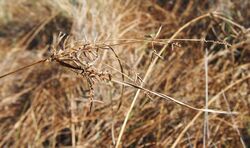Biology:Cyperus gilesii
| Giles' flat-sedge | |
|---|---|

| |
| Scientific classification | |
| Kingdom: | Plantae |
| Clade: | Tracheophytes |
| Clade: | Angiosperms |
| Clade: | Monocots |
| Clade: | Commelinids |
| Order: | Poales |
| Family: | Cyperaceae |
| Genus: | Cyperus |
| Species: | C. gilesii
|
| Binomial name | |
| Cyperus gilesii Benth.
| |
Cyperus gilesii, commonly known as Giles' flat-sedge,[1] is a sedge of the Cyperaceae that is native to Australia.
Description
The annual or perennial sedge has a slender tufted habit. It has smooth trigonous or triquetrous shaped culms that are typically 10 to 35 cm (3.9 to 13.8 in) in height with a diameter of 0.8 to 2 mm (0.031 to 0.079 in) diameter.[2]
The septate to nodulose leaves are shorter than the culms and have a width of about 4.5 mm (0.18 in). The sedge flowers in spring and summer producing simple inflorescences with one to five branches that have a length of around 6 cm (2.4 in). The dense flower clusters are subdigitate with a hemispherical to globose shape and a diameter of around 50 mm (2.0 in). There are one to three leaf-like involucral bracts. There are many flattened spikelets per cluster that have a length of 10 to 30 mm (0.39 to 1.18 in) and a width of 2.5 to 4.5 mm (0.098 to 0.177 in) containing 8 to 34 golden brown to red-brown flowers. After flowering a trigonous very narrow-ellipsoidally shaped red-brown to grey-brown nut forms that has a length of 2.0 to 5.0 mm (0.079 to 0.197 in) and a 0.3 to 1.0 mm (0.012 to 0.039 in) diameter.[2][1]
Taxonomy
The species was first formally described by the botanist George Bentham in 1878 in the work Flora Australiensis.[3] The specific epithet honours the explorer William Ernest Powell Giles who led five major expeditions throughout central Australia.[1]
Distribution
C. gilesii is found throughout Australia. It is common throughout Queensland, northern South Australia, northern New South Wales and eastern parts of the Northern Territory.[4][1] In Western Australia it only occurs only rarely in the Pilbara region.[5] It is often situated ephemerally wet situations, including inland stream and river banks, floodplains and roadside drains.[2]
See also
- List of Cyperus species
- Plants using Giles names
References
- ↑ 1.0 1.1 1.2 1.3 "Cyperus gilesii (Cyperaceae) Giles' Flat-sedge". Seeds of South Australia. Government of South Australia. http://saseedbank.com.au/species_information.php?rid=1349. Retrieved 13 November 2018.
- ↑ 2.0 2.1 2.2 "Cyperus gilesii Benth.". PlantNet. Royal Botanic Garden, Sydney. http://plantnet.rbgsyd.nsw.gov.au/cgi-bin/NSWfl.pl?page=nswfl&lvl=sp&name=Cyperus~gilesii. Retrieved 13 November 2018.
- ↑ "Cyperus gilesii Benth.". Alas of Living Australia. Global Biodiversity Information Facility. https://bie.ala.org.au/species/http://id.biodiversity.org.au/node/apni/2902608#names. Retrieved 13 November 2018.
- ↑ "Occurrence records". Australasian Virtual Herbarium. https://avh.ala.org.au/occurrences/search?taxa=Cyperus+gilesii#tab_mapView. Retrieved 3 September 2018.
- ↑ "Cyperus gilesii". FloraBase. Western Australian Government Department of Parks and Wildlife. https://florabase.dpaw.wa.gov.au/browse/profile/39760.
Wikidata ☰ Q15532913 entry
 |



